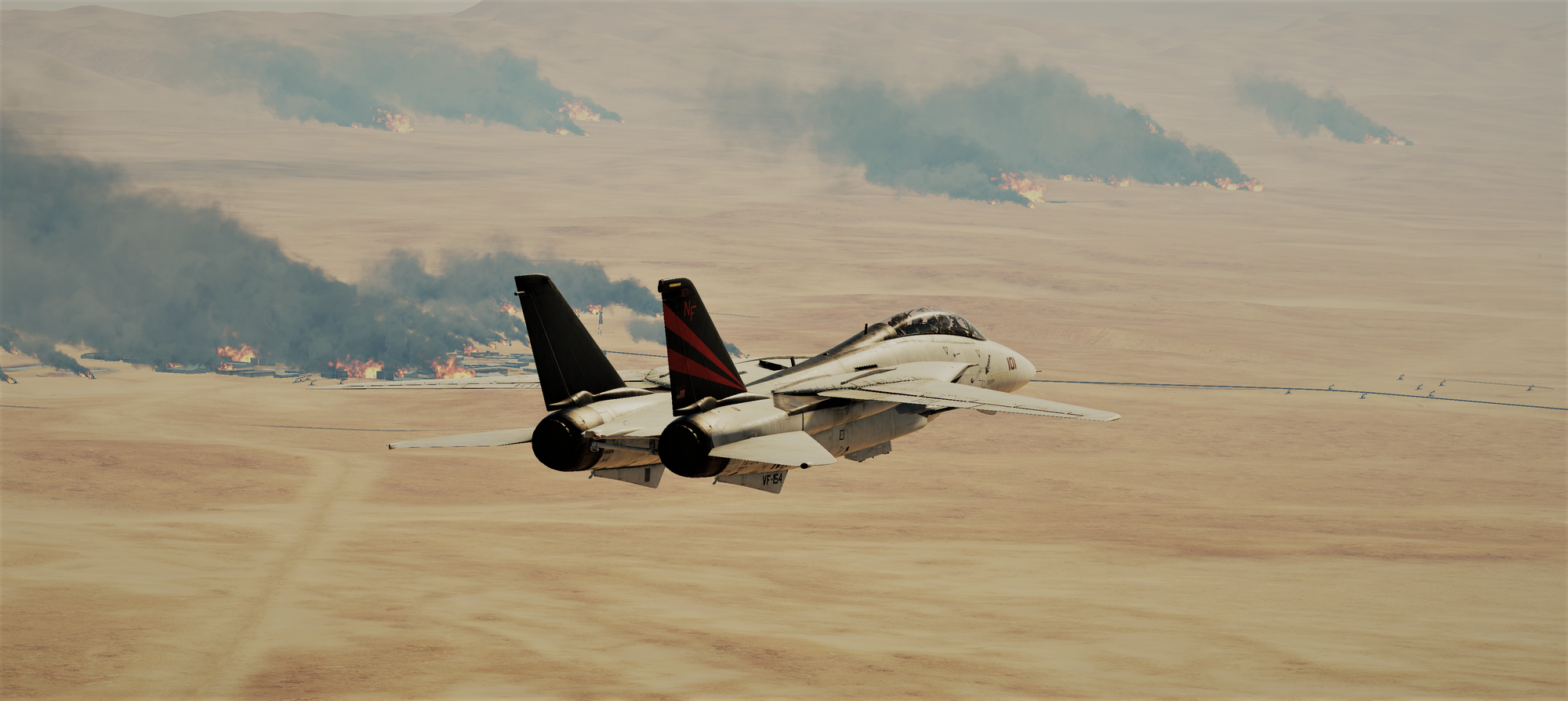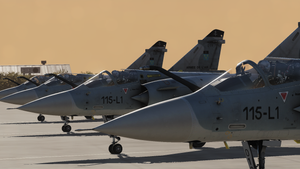In the previous "down the rabbit hole"I said that DCS is fun. It's really fun, but to anyone that hasn't jumped into it the gameplay appears somewhere between boring and confusing. Just a lot of flying around and pressing buttons, so let's have a look at a quick fly-out on one of the dynamic PVP servers and see what's actually going on!
I'm back from work, I have half an hour free before I have to start preparing dinner. Just enough time to get a "sortie" in. I boot up DCS and have a look at the server list. Quite busy on a Friday evening. I see that one of the dynamic campaign servers I've been flying on is stacked. Our side, Red, has been losing horribly for a couple of weeks now but it looks like they're doing a Hail Mary assault on one of the Blue airfields north of Ossetia.
I jump in and get into the cockpit of the JF-17 Thunder - a modern Chinese-Pakistani multi-role fighter jet that's all kinds of strange. (See the appendix below for some JF-17 trivia). Compared to the American jets on the enemy team it's rather anaemic in raw performance and endurance, but it makes up for it in cutting edge avionics and tech, a decade or two more modern than the enemy's. That's perfect for what I intend to do - orbit high above the battlefield equipped with precision air-to-ground weaponry, an infrared "targeting pod" camera and be the eye in the sky for my teammates.
After starting up, I tune one of the radios to the "AWACS", which is essentially an airliner orbiting safely behind the front lines at 35,000ft, with a big radar on it's back. This will give me a data-link connection allowing me to see what's going on in the skies above the enemy airfield, and get intercept calls to any enemies. The other radio I tune to 251.000 MHz AM, the battle frequency of my team. Immediately I hear a guy yelling into his mic about hidden air defences in the town next to the airfield, as he goes down in flames. I notice that there's a ground commander on the enemy team. So someone is directly controlling the enemy's ground units - this should be fun.
I take off and head out to the battle. Several teammates are already there performing "SEAD" - suppression of enemy air defences. It's the first step of a ground assault. Take out, or suppress the anti-air defences so you can then get in close to kill what's on the ground without it shooting back at you from a long way away.
There are many ways to conduct SEAD, and the choice of tactic depends on what you're going up against. Certain long range, radar guided surface to air missiles (SAMs) can launch on you from 40 miles away, but they give off radar emissions that "anti-radiation" missiles can home in on. These emissions are also detected by your aircraft's radar warning receiver (RWR), giving you a heads up and time to react if you've been fired upon. Up close, you might encounter short range IR SAMs. These use passive seekers that lock on to your aircraft's heat signature. Your RWR can't help you here, but luckily the JF-17 has "IR bloom sensors" around its tail that can detect the heat flash of a missile launch. It only has a detection range of a few miles however, and has many blind spots. Often the alarm from this system is just the harbinger of imminent death rather than a useful forewarning.
Luckily I've come prepared for this fight. Under the wings I have four anti-radiation missiles to take out the radar guided SAMs and two glide bombs for when I can get a bit closer. These glide bombs will detach, spread their wings and glide down to whatever point I've designated using the targeting camera. On the wing tips I have two short range infrared guided air to air missiles, just in case I run into trouble.
During Operation Thunder of the Vietnam War, the US Air Force developed a SEAD tactic called the Wild Weasel. It's nothing short of insanity and involves playing a deadly game of chicken with the SAMs. The goal is to bait the enemy into turning on their radars so the anti-radiation missiles can lock on and destroy them. Often you would have the wild weasel planes that would fly towards the SAMs and act as the bait. Another flight carrying the missiles waits for the radar ping to fire upon them. Ridges, buildings and other terrain features are used for cover that the wild weasel flight can duck behind when they get fired upon, but if they run away too soon, the enemy will shut off their radars and be on the move before the anti-radiation missiles can reach them. Often, the presence of wild weasel teams in the area would make the enemy too afraid to turn the radars on at all, which is essentially a win anyway. With radars off, they can't fire and they are not a threat. A common defensive tactic by a pilot who has just had a radar SAM fired at him is to yell "magnum" over the radio guard frequency. This is the NATO codeword for having fired an anti-radiation missile. Betting that the enemy is monitoring communications, this might cause them to panic and shut down the SAM system, just in case it was a genuine call.
The rather apt motto of the Wild Weasel crews was YGBSM: "You Gotta Be Shittin' Me".

With a human at the helm of the enemy SAM systems, I expect a good deal of wild weaselling to play out. This happens almost immediately as I approach the battlefield. I see a thin white trail streaking up from the town. An enemy SAM has fired on one of my teammates. This is where the video begins:
I immediately declare the launch over the radio, warning the friendly of the impending union with an unfriendly missile. At the same time, I slew over my targeting pod to the general area in which I saw the launch. I begin scanning the area to see where the launch came from, and before long I see an enemy "TOR" missile system driving full speed across the ground, hastily trying to reposition after firing. The Russian developed SA-15 TOR, of recent and unfortunate infamy was designed specifically for this kind of fight - able to fire, shut down the radar and be on the move within seconds in order to keep its position hidden.
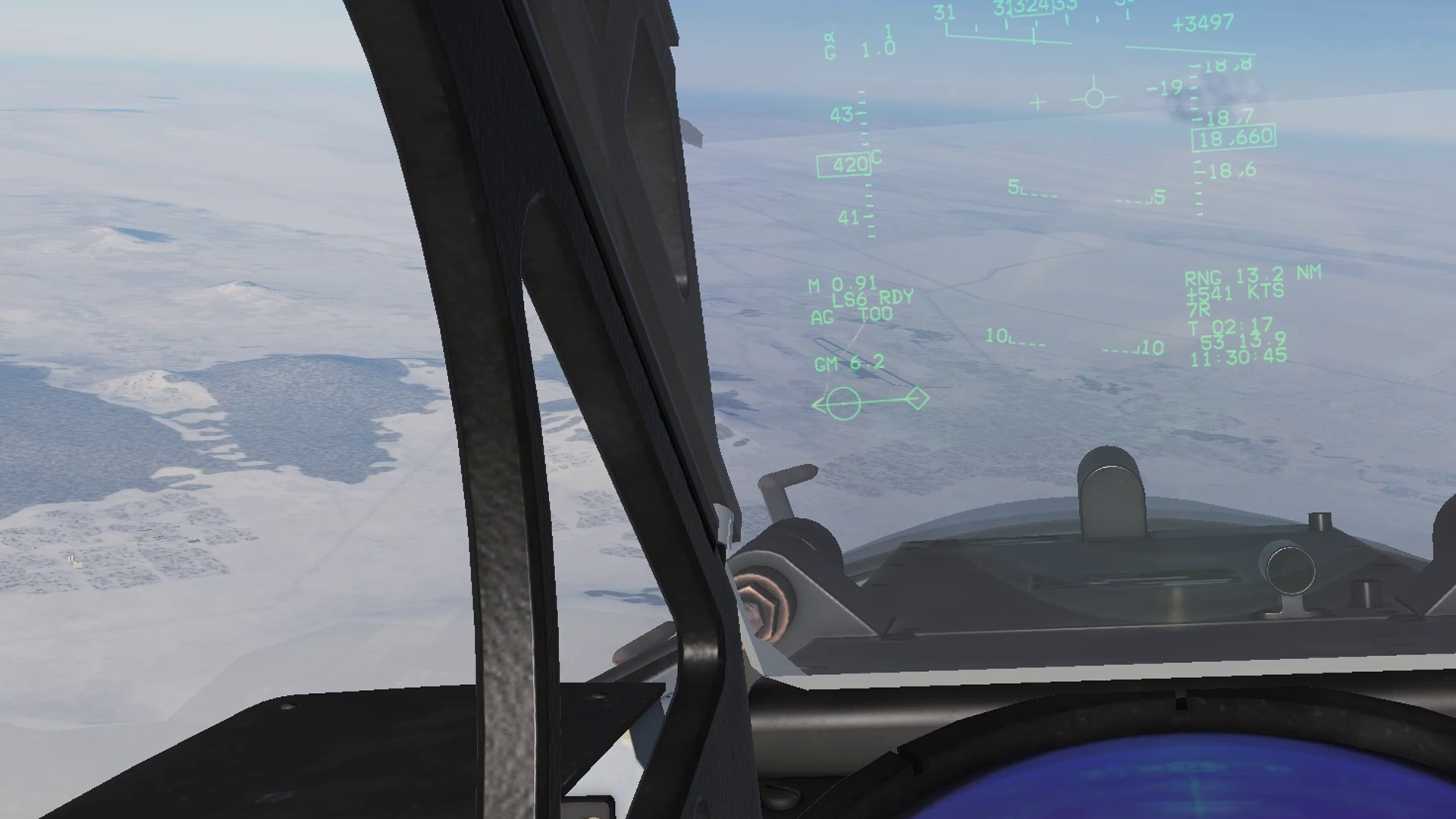
Luckily, I have him tracked on the camera, which has locked onto the edge contrast it is making against the cold snow. I have my missiles in "ACT" mode, meaning they will search for a radar signature in the vicinity of where the camera is pointing, but as I fire them, he deactivates the radar and the signal is lost. My missiles explode where the TOR was just seconds earlier. He then reaches a group of trees and stops to reactivate the radar and acquire a lock on me. He thinks he's hidden, but the camera is still tracking. I wait for the "ping" on my RWR - which in the case of the JF-17 is a red cross-hair on the display and a soothing Chinese voice repeating the word "tracking" to me. A launch is imminent, but if I can get my missile off quick enough it will be at best a kill for me, and at worst a trade. I roll in and fire immediately. Anticipating a launch from him in this game of chicken, I go defensive. I dive for the ground on a vector perpendicular to the TOR, while expending chaff - clouds of Mylar strips from the rear of the aircraft.

Diving for the ground makes it more likely I will find cover to break the line of site between myself and the missile. It also might put the intercept point, which the missile will be continuously calculating, below ground level, causing it to slam into the earth or some poor babushka's house. Diving perpendicular to the TOR is a tactic called notching. Attack radars track targets using the "Doppler pulse" method. They filter the target out of the background clutter by measuring the Doppler frequency shift between the transmitted and received radar signal. Like the dinosaurs in Jurassic Park, if you don't move they can't see you. At a perpendicular vector, my relative velocity with respect to the TOR is close to zero, and I look like scenery. This is called hiding in the notch filter. Finally, expending chaff countermeasures creates clouds of highly reflective (for radar) material behind me, which the missile might decide is more favourable than the radar return from my plane.
Before his missile reaches me, my missile connects. I see the TOR explode on my targeting pod in a thick black plume - representing scorching hot in the infrared regime. With the TOR radar destroyed, his missile in the air can no longer track me. I announce "shack" over the radio, letting my team know the TOR is dead.
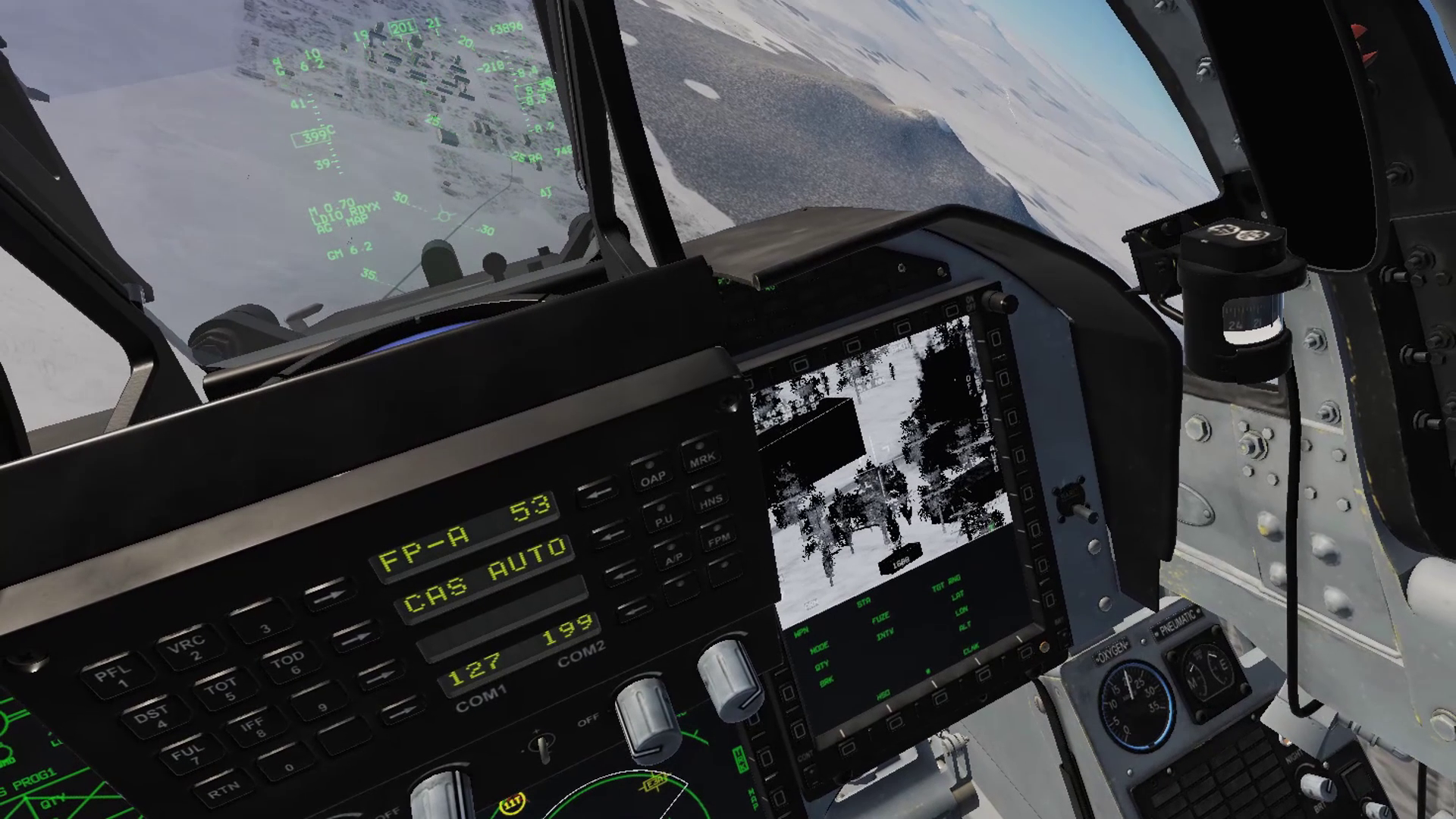
That SAM has been taken care of but the town is no doubt still bristling with short range infrared guided defences. I climb back up to altitude, safe from these units, and begin scouring the enemy airfield for potential targets for the glide bombs. As I scan around I see a small black pixel flying across the screen parallel to the runway. Zooming in, I see it's an enemy fighter - an F-5 Tiger - taking off to intercept us invaders. I declare it over the radio and a teammate who is flying "CAP" (Combat Air Patrol) responds. CAP is a pure air-to-air fighting role which usually involves orbiting just on the edge of the engagement zone, waiting for enemy aircraft to pop up so they can burn in and engage them.
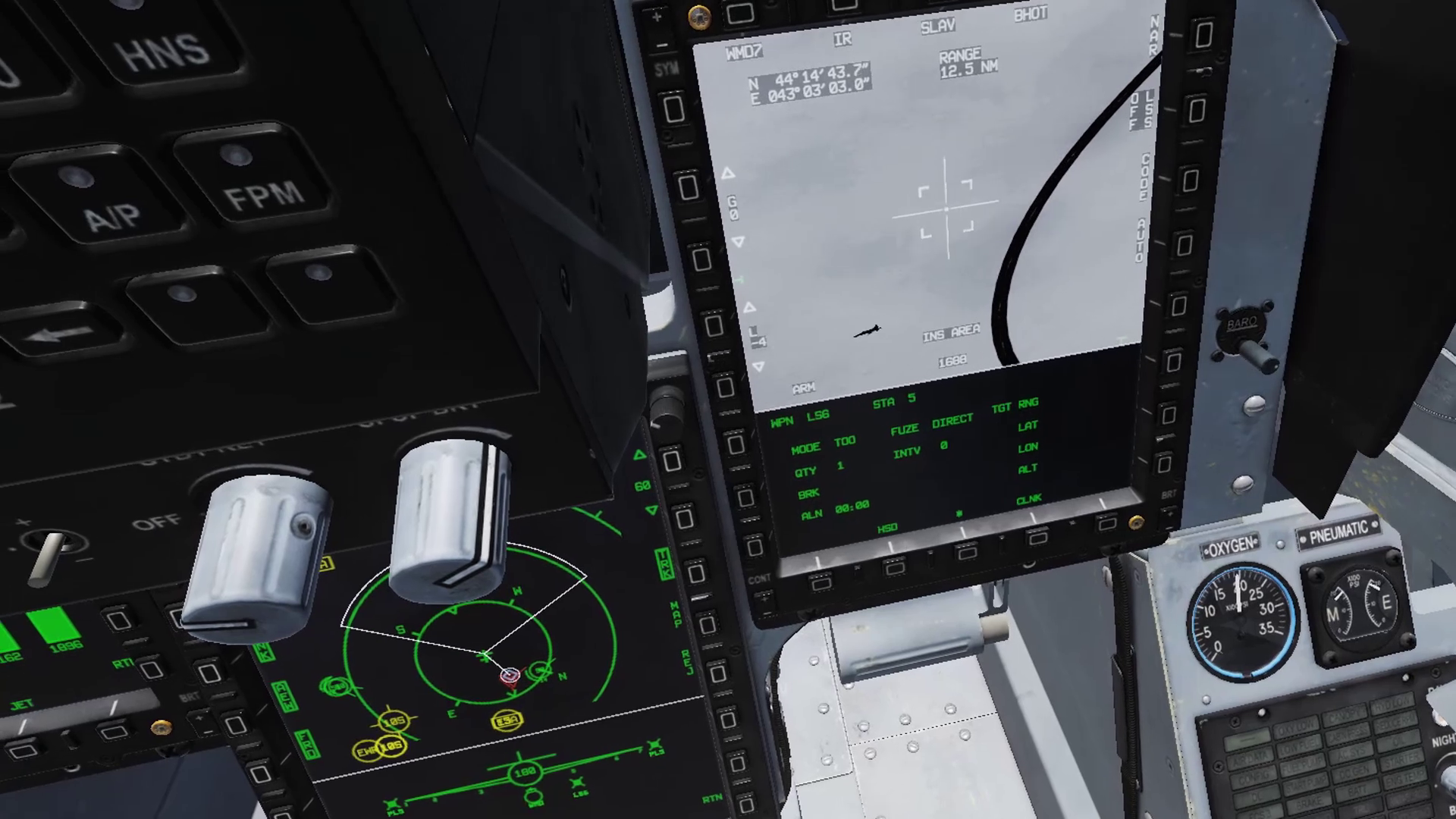
The CAP guy announces that he's in hot on the enemy F-5, but he's still some distance away and the F-5 is quickly approaching some friendly helicopters who are busy clearing out the town. I have a couple of short range air-to-air missiles on my wing tips and I'm much closer, so I decide to dive in on the enemy. As I get down on the deck, I see that the F-5 is "merged" with a friendly. They are too close to get reliable radar returns, and I cannot trust my IFF system. IFF uses a transponder and a receiver to fire an interrogation beam at the target from the radar. If the target understands the encoded interrogation, it will return a signal declaring that they are friendly. If, however, the signal is not understood, it will return nothing. This likely means (but not always) that they are enemy. Team killing is a tragic affair in DCS. It can be frustrating to die to a teammate, lose one of your precious lives and have to go through start up procedures, re-arming and fly back out to the battle. I'd rather be sure before pushing that missile launch button, so I head in to "the merge" to try and get a visual ID. The AWACS controller calls "merged" over the radio as he sees our radar tracks become one. He flies past me and the short glimpse I get of him confirms to me that it's the enemy F-5. I start coming back around to fire off a missile but then the CAP guy from earlier announces "fox 3" over the radio.
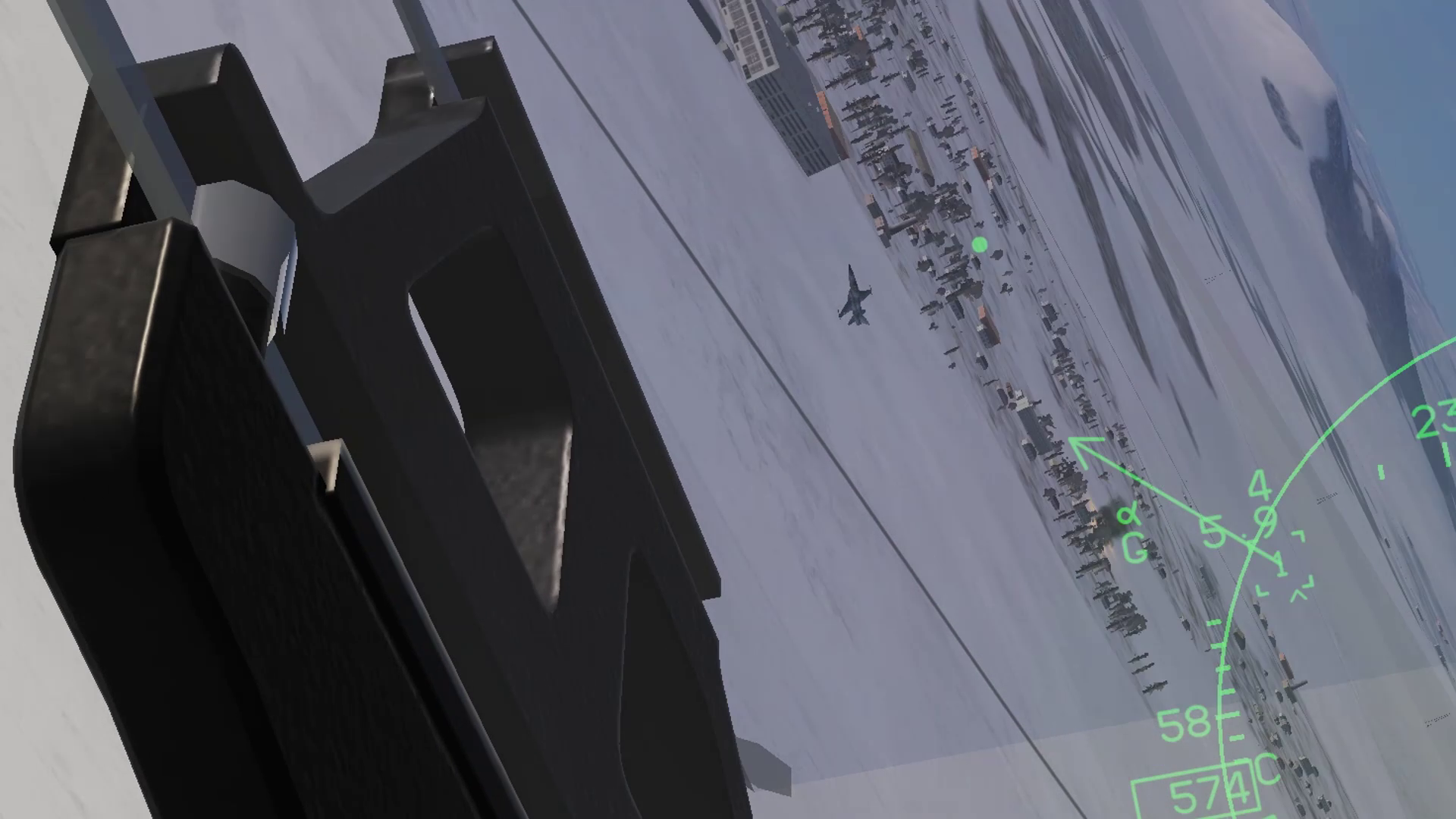
Now this puts me in a predicament. That "fox 3" means that he has fired an active radar homing missile at the enemy. These missiles are guided towards the target by the host aircraft's radar, and then for terminal guidance, the missile switches on its own radar in its nose and guides itself the rest of the way. This switch between aircraft and missile radar guidance either happens at a certain distance, amount of time, or if the host radar loses the contact. If I fire on the F-5 and blow it up, then the plane that just fired the missile at him will lose the contact. This will force his missile to "go active" and turn on its own radar to search for the target itself. In which case, it won't find the recently disintegrated F-5, it will find the next closest thing - me!
So instead, I cross the F-5 in another head on pass as I wince, expecting to see the flash of a missile launch from his wing. I hear a clunk as the glide bombs are ripped from my wings due to the g-forces of the turn. I've positioned myself in a way that obscures my hot engine nozzle from his field of view. I know that the F-5 can only carry what are know as rear aspect IR missiles - they can only lock onto the heat directly coming from the engine exhaust and not onto the heat of the aircraft's skin like more modern variants. As we pass again, I spam the button that releases the chaff. There's a chance, as we cross, that the incoming fox 3 missile will accidentality switch to the wrong radar return as our reflected signals merge and then separate again. Wincing slightly again, as I half expect the instant fiery death from the inbound friendly missile, I see the F-5 explode in a flash behind me. It all worked out in the end.
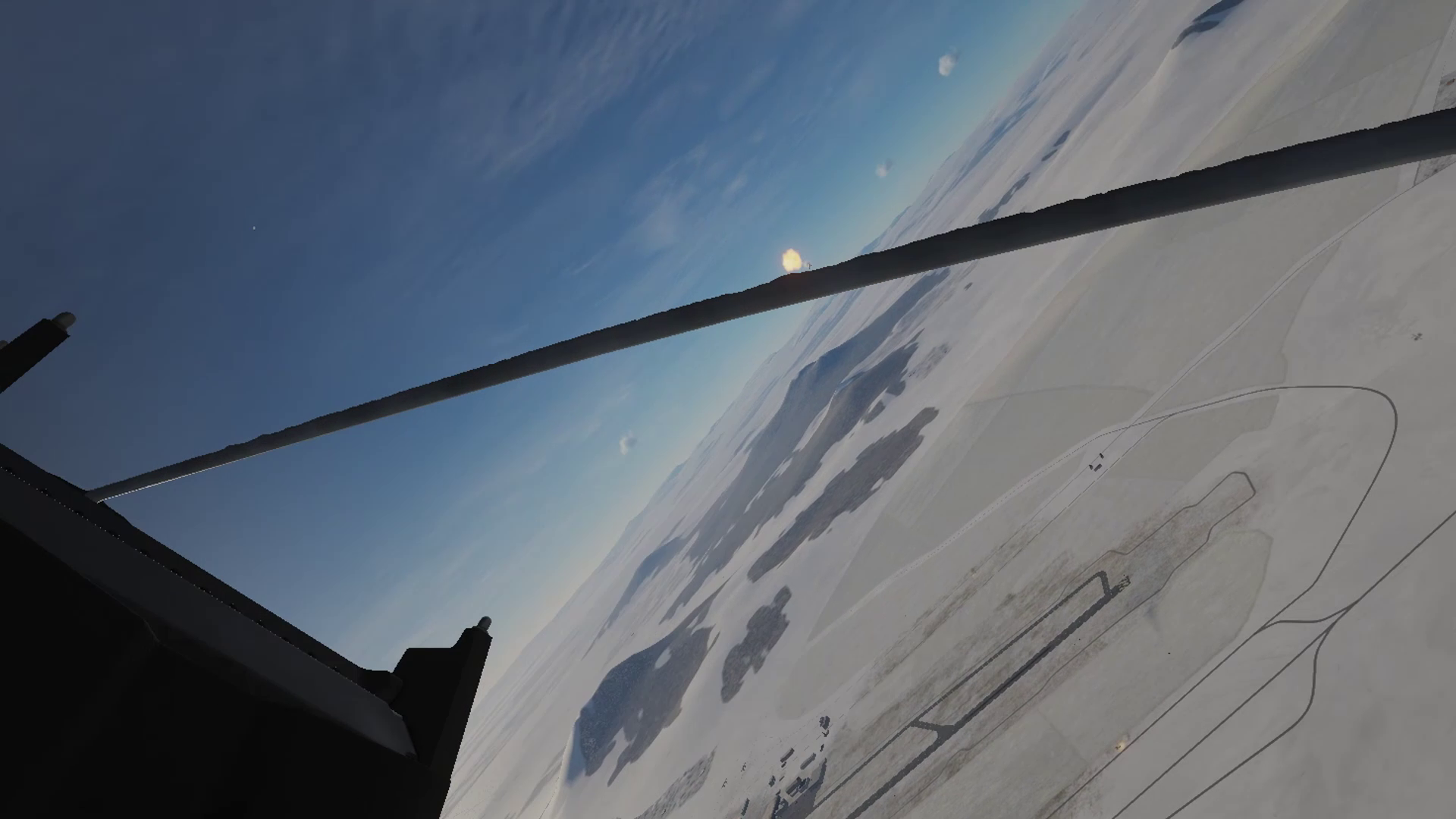
I tell the friendly CAP I saw his target explode but his reply is one of resignation. In his quest for the kill he had overflown the town and been hit by another TOR. Heavily damaged, he has to return to base. Looking down at my RWR I see that I'm about to be the ground commander's next victim. The word MISSILE flashes on the heads up display as several launch warnings are detected behind me by the bloom sensors. During the dance with the F-5 I'd strayed too close to the enemy airfield!
I get low and fast to try and evade them while heading towards the cover of a hill in the distance. Once safe I start to climb back up to altitude, where the air is thin and the fuel consumption is efficient. Seconds later I get a master alarm - "bingo fuel". The fuel gauge goes from yellow to red as I approach 1000lb left in the tank. On full afterburner this is about a minute more of flight time, but I'm still 40 miles from home. I come back on the throttle and manage to idle it down to the friendly base on fumes.
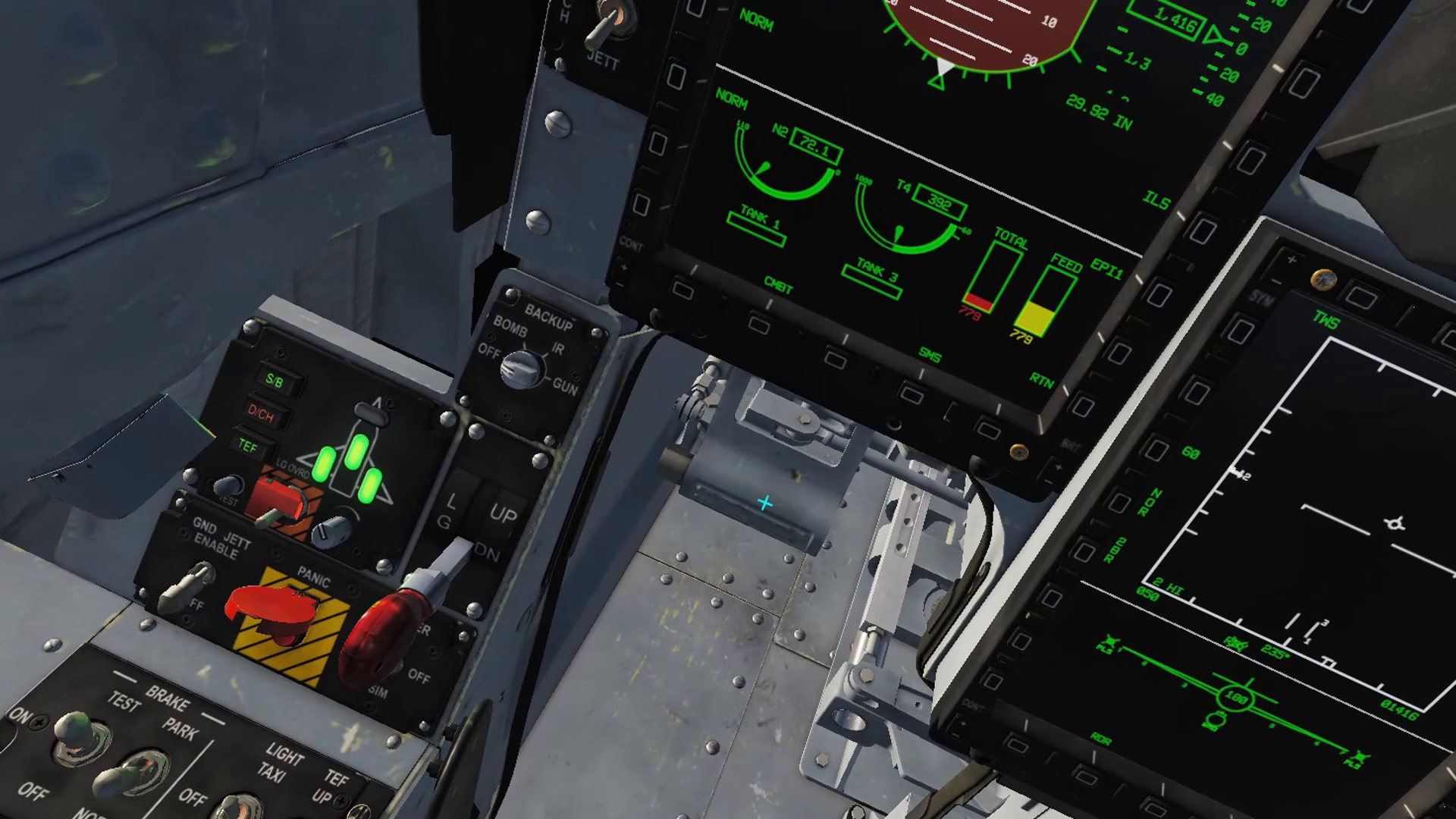
I wish everyone good luck and log off for the evening. After dinner, I check the live web map and see the airbase is still very much under blue control. After a couple of weeks of fighting that looks like the death knell for Red. Ah well, better luck next war!

My name's Jeff
Recently, the "JF-17 Thunder", multi-role 4th generation fighter jet, affectionately called Jeff was added to the DCS repertoire. Developed by a Chinese 3rd party company Deka Iornworks, their debut full-fidelity aircraft was a huge hit. Released feature complete with an incredible attention to detail, Jeff is unique in DCS as it is surprisingly modern.

In general, DCS lags behind the real world by about two decades or so. Classified information and arms regulations such as ITAR severely limit the amount of publicly available information on modern aircraft, weapons and avionics especially if those systems are still in service. Developers are extremely careful in procuring such information, nevertheless one of Eagle Dynamic's developers was recently extradited from Georgia to the US after Homeland Security got him in a sting operation trying to buy an F-16 operations manual. These documents are completely de-classified and anyone in the US or Europe can buy one off eBay if they wish. The issue was that the dev was Russian, so the transfer of the manual violated ITAR. He spent a few years in prison before returning home where his job at ED still waited for him.
Yet here, with Jeff, we have a fighter jet developed in the 2010s and still coming fresh off the production line for the Pakistani air force, fully simulated with all the modern bells and whistles. How this is possible is due to the unique way the real JF-17 was developed.
During the Soviet-Afghan war, India was allied with the Soviets, while Pakistan was supplying military aid to the Afghani insurgents, so via "my enemy's enemy..." the US agreed to sell the cutting edge F-16 Fighting Falcon, or "Viper" to Pakistan. However, after the fall of the Soviet Union and due to the continued development of their nuclear programme, Pakistan was placed under arms embargo by the US and the supply of F-16s stopped. Even now, these F-16s from the cold war make up the backbone of the Pakistani air force, yet they are aging and like iphones with proprietary chargers, they can only use US-made compatible weapons. They have been seeking a replacement in order to move away from their reliance on US tech, and China came up with the answer - the JF-17.

The development of the JF-17 is a strange one; constantly shaped along it's history by ever changing international relations. At one point, even US arms manufacturer Grumman was involved before US-China relations soured. This short partnership is often referred to as "Uncle Grumman's wild night out."
After decades of development, with ever changing partners, goals and designs, we end up with the JF-17. A cheap, light, multi-role attack fighter designed to be as easy as possible for pilots to transition to from the F-16. It has the wings, throttle and stick of the Viper; the 23mm cannon of a soviet 1950's Mig-21 interceptor; the engine of the 1980's Mig-29; the navigation avionics of a French private jet manufacturer and an off the shelf Chinese attack radar.
And that's why so much can be publicly known about a very capable, modern fighter jet. It's a Frankenstein's monster of cold war jet parts and off-the-shelf components from the civilian and military international market.

